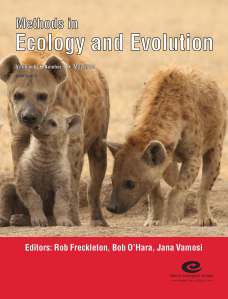Issue 6.5 is now online!
 The May issue of Methods is now online!
The May issue of Methods is now online!
We have two freely available articles this month: one Application and one Open Access Article.
– rSPACE: An open-source R package for implementing a spatially based power analysis for designing monitoring programs. This method incorporates information on species biology and habitat to parameterize a spatially explicit population simulation.
Tim Lucas et al. provide this month’s Open Access article: A generalised random encounter model for estimating animal density with remote sensor data. The authors have developed a Generalised Random Encounter Model (gREM) to estimate absolute animal density from count data from both camera traps and acoustic detectors. They show that gREM produces accurate estimates of absolute animal density for all combinations of sensor detection widths and animal signal widths. This model is applicable for count data obtained in both marine and terrestrial environments, visually or acoustically. It could be used for big cats, sharks, birds, echolocating bats, cetaceans and much more.
Lucas et al.’s article is included within an impressive ‘Remote Measurements’ section of the issue. Other articles in this section include:
- A description of the application of a robotic camera system (Lynch et al.)
- A test of test the capability of Magneto-Inductive tracking for recording underground movement (Noonan et al.)
- A method for underwater volume and surface area evaluation using 3D computer modelling (Lavy et al.)
- A comparison of models for monthly mean and daily afternoon temperatures, for open and tree-covered habitats (Gunton et al.)
We also have articles on Detection Modelling, Diversification Rates, Behavioural Ecology, Microbial Ecology, Dispersal and Demographic Modelling.
This month’s cover image shows a female spotted hyaena with her cub and a young adult male at the communal den in the Ngorongoro Crater, Tanzania. Spotted hyenas are highly social carnivores living in female-dominated groups that are structured by strict hierarchies. Social challenges are known to elicit an endocrinological response and a well-established, method to examine this response is to measure hormone metabolites from faeces or urine using enzyme immunoassays. The accuracy of an enzyme immunoassay may vary due to fluctuations in lab conditions.
In their article, ‘Determining hormone metabolite concentrations when enzyme immunoassay accuracy varies over time‘, Eve Davidian et al, develop a simple method to standardise hormone metabolite concentrations based on the re-assaying of a subset of samples. Their method is an alternative to the costly and time-consuming re-assaying of complete sample sets. The article provides comprehensive guidelines to identify changes in measurements accuracy and estimate the minimum number of samples required to obtain reliable results.
Photo © Eve Davidian.
To keep up to date with Methods newest content, have a look at our Accepted Articles and Early View articles, which will be included in forthcoming issues.
